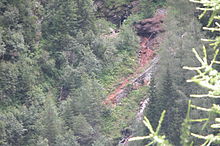Arsenic
![]()
This article is about the chemical element. For other meanings, see Arsenic (disambiguation).
Arsenic [aʁˈzeːn] is a chemical element with the element symbol As and atomic number 33. In the periodic table of the elements it is in the 4th period and the 5th main group, or 15th IUPAC group or nitrogen group. Arsenic rarely occurs in pure form, mostly in the form of sulfides. It belongs to the semi-metals, as it shows metallic or non-metallic properties depending on the modification.
In colloquial language, arsenic, which is known as a murder poison, is usually simply called "arsenic". Arsenic compounds have been known since ancient times. As a mutagenic clastogen, arsenic compounds can act as a poison, which can cause chromosomal aberrations and thus have a carcinogenic effect.
Arsenic is used for doping semiconductors and as a component of III-V semiconductors such as gallium arsenide. The organic arsenic compound arsphenamine (Salvarsan) was considered a breakthrough in the treatment of syphilis in the early 20th century, despite severe and most serious side effects. Today, arsenic trioxide is used as the last treatment option in the therapy of promyelocytic leukemia.
History
The name arsenic goes back to the ancient Greek ἀρσενικόν arsenikón, the ancient name of the arsenic mineral auripigment. It is found as early as Dioscorides in the 1st century. The Greek name, for its part, seems to have its origin in the Old Persian (al-)zarnik (golden, auripigment, "arsenic") and probably entered Greek through Semitic mediation. Folk etymologically, the name was mistakenly derived from the homonymous (Old and Modern) Greek word αρσενικός arsenikós, which translates roughly as male/strong. It is only since the 19th century that the name arsenic has been in common use. The element symbol was proposed by Jöns Jakob Berzelius in 1814.
The first contact of humans with arsenic can be traced back to the 3rd millennium BC: Large amounts of arsenic could be detected in the hair of the mummy of the Alpine dweller popularly known as Ötzi, preserved in glacial ice, which is archaeologically interpreted as an indication that the man in question was involved in copper processing - copper ores are often contaminated with arsenic. In classical antiquity, arsenic was known in the form of the arsenic sulfides auripigment (As2S3) and realgar (As4S4), described for instance by the Greek Theophrastus, Aristotle's successor. The Greek philosopher Democritus also had demonstrable knowledge of arsenic compounds in the 5th century BC. The Leiden Papyrus X from the 3rd century AD suggests that they were used to color silver gold-like and copper white. The Roman Emperor Caligula had reportedly commissioned a project to produce gold from the (golden yellow) auric pigment as early as the 1st century AD. The alchemists, who were aware of arsenic compounds as evidenced by their mention in the standard ancient work Physica et Mystica, suspected a relationship with sulfur and mercury. Arsenic(III) sulphide was used as a painter's colour and depilatory, as well as for the external and internal treatment of lung diseases.
In the Middle Ages, arsenic (arsenic(III) oxide) was found in metallurgical smoke (dust-laden waste gas from metallurgical furnaces). Albertus Magnus first described the production of arsenic by reducing arsenic with coal around 1250. He is therefore considered the discoverer of the element, although there is evidence that the elemental metal was produced earlier. Paracelsus introduced it into medical science in the 16th century. Around the same time, arsenic preparations were described in the Chinese encyclopedia Pen-ts'ao Kang-mu by the pharmacist Li Shi-zhen. This author particularly emphasizes its use as a pesticide in rice fields.
In the 17th century, yellow auric pigment became popular with Dutch painters as royal yellow. As the pigment converts to arsenic(III) oxide over long periods of time and crumbles from the canvas, difficulties arise during restoration. From 1740 arsenic preparations were used successfully in Europe as mordants in crop protection. However, this use was banned again in 1808 because of its high toxicity. The use of arsenic additives for lead casting is based on the greater hardness of such lead alloys; typical applications are shot balls. Although its toxicity and use as a homicidal poison was well known, arsenic was one of the most important asthma remedies in the early 19th century. It is apparently based on reports that the Chinese were said to smoke arsenic in combination with tobacco to get lungs that were as strong as bellows. Also until the 19th century, arsenic compounds were used externally and internally for malignant tumours, skin diseases and (for example in the form of Fowler's drops) for fever.
Arsenic was used in the form of copper arsenates in colorants such as Paris green to print wallpaper. When exposed to high humidity, these pigments were converted by mold into toxic volatile arsenic compounds, which not infrequently led to chronic arsenic poisoning.
But arsenic was also used in wars: In World War I, arsenic compounds were used in chemical warfare agents (Blue Cross) or lewisite. By attacking the skin and lungs, they caused cruel pain and the most severe physical damage to the victims.

Symbol of the alchemists for arsenic

Albertus Magnus is considered the first manufacturer of pure arsenic
Extraction and presentation
Arsenic is produced in large quantities as a by-product of the extraction of copper, lead, cobalt and gold. This is the main source of commercial use of the element.
It can be obtained by thermal reduction of arsenic(III) oxide with coke or iron and by heating arsenopyrite (FeAsS) or arsenical lime (FeAs2) in the absence of air in horizontal clay pipes. In this process, elemental arsenic sublimates and returns to the solid state on cold surfaces.
Arsenopyrite decomposes into iron sulfide and elemental arsenic.
Arsenical gravel decomposes into iron arsenide and elemental arsenic.
For semiconductor technology, arsenic, the purity of which must be above 99.99999 percent, is produced by reducing arsenic(III) chloride distilled several times in a hydrogen stream:
Arsenic trichloride reacts with hydrogen to form hydrogen chloride and elemental arsenic.
In the past, it was also produced by sublimation from solutions in liquid lead. In this process, the sulfur of the arsenic ores is bound by the lead in the form of lead(II) sulfide. The purities of over 99.999 percent achieved in this process were not sufficient for semiconductor applications. Another possibility is crystallization at high temperatures from molten arsenic or conversion into monoarsane, subsequent purification and decomposition at 600 °C into arsenic and hydrogen.

Former arsenic mines below the Rotgüldensee lake in Lungau
Search within the encyclopedia


